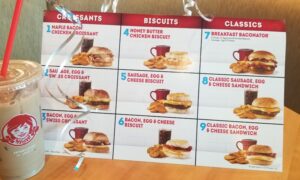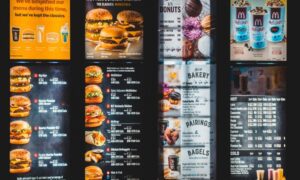In the gastronomic realm, menus serve as the culinary compass, guiding patrons through a symphony of flavors, textures, and aromas. A menu is not just a list of dishes; it is an intricate storytelling device, a reflection of a restaurant’s identity, and a crucial tool in creating a memorable dining experience. In this comprehensive guide, we will delve into the nuances of what exactly constitutes a menu in a restaurant, exploring its diverse types and elements and the pivotal role it plays in the overall dining ecosystem. After this article, if you wish to create a menu for your cafe or restaurant, check out this menu maker app.
What is a menu?
A menu in a restaurant is a list or collection of food and beverage items that the establishment offers to its customers. It serves as a guide for patrons to choose their desired dishes, providing information about the available options, their descriptions, and often their prices. Menus come in various formats, ranging from traditional printed sheets to digital displays, and they play a crucial role in shaping the dining experience.
The term “menu” has evolved over time, originally stemming from the Latin word “minutus,” meaning small. In the context of a restaurant, a menu is not just a practical list of offerings; it is a communication tool that conveys the restaurant’s culinary identity, style, and ethos to its guests.
There are different types of menus, each with its own characteristics and purposes. Common types include à la carte menus, prix fixe menus, tasting menus, and buffet-style menus. The format and content of a menu can vary widely based on the type of cuisine, the restaurant’s concept, and the preferences of both the chef and the target audience.
Types of Menus:
A. À la Carte Menu:
Definition: The term “à la carte” is French for “on the card” or “on the menu.” In this type of menu, individual dishes are listed separately, each with its own price.
Characteristics: Customers have the flexibility to choose dishes independently, creating a personalized dining experience. Prices are associated with each item, and the total cost depends on the items selected.
B. Prix Fixe Menu:
Definition: “Prix fixe” translates to “fixed price” in French. In this menu format, a set number of courses are offered at a predetermined price.
Characteristics: The customer selects a fixed number of courses from a limited menu, and the price remains constant. This format is popular in fine dining establishments and provides a structured dining experience.
C. Tasting Menus:
Definition: Tasting menus, also known as degustation menus, showcase a sequence of small portions of dishes selected by the chef.
Characteristics: Often found in upscale restaurants, tasting menus offer a curated culinary journey. Diners experience a variety of flavors and techniques, showcasing the chef’s creativity and skill.
D. Buffet Style:
Definition: Buffet-style menus involve a self-service arrangement where a variety of dishes are displayed and customers serve themselves.
Characteristics: Common in casual dining, events, and certain cultural contexts, buffets allow customers to choose from a range of dishes. Pricing is typically fixed, and the emphasis is on variety and abundance.
E. Table d’Hôte Menu:
Definition: This French term translates to “host’s table.” Similar to a prix fixe menu, it offers a complete meal at a fixed price, but it may allow more flexibility in choosing courses.
Characteristics: Customers can select from a set menu that includes appetizers, main courses, and desserts. While there’s a fixed price, there might be more choices within each course compared to a traditional prix fixe menu.
F. Cycle Menu:
Definition: Commonly used in institutional settings like schools or hospitals, a cycle menu rotates a set of meals over a specific period.
Characteristics: The menu repeats on a predetermined cycle, providing variety and ensuring that customers do not encounter the same dishes every day. This approach simplifies planning and logistics.
G. Static Menu:
Definition: Also known as a fixed menu, a static menu remains unchanged for an extended period.
Characteristics: Common in fast-food restaurants and diners, a static menu allows for consistency in offerings. While items may be added or removed occasionally, the core menu remains stable.
H. Du Jour Menu:
Definition: “Du jour” means “of the day” in French. This menu features specials or dishes that are available on a specific day.
Characteristics: The du jour menu often highlights fresh, seasonal ingredients and adds an element of variety to the regular menu. It encourages customers to try something new.
Elements of a Menu:
1. Dish Descriptions: Each item on the menu is accompanied by a description that provides details about the ingredients, preparation methods, and sometimes the chef’s inspiration behind the dish.
2. Prices: The cost of each item is usually indicated, allowing customers to make informed decisions based on their budget.
3. Sections: Menus are often organized into sections, such as appetizers, mains, desserts, and beverages, making it easier for customers to navigate through the available options.
4. Specials and Recommendations: Some menus feature special dishes, chef’s recommendations, or seasonal offerings, adding an element of excitement and variety.
5. Dietary Information: In response to increasing dietary awareness, menus may include information about vegetarian, vegan, gluten-free, or other dietary options.
Menu Design and Psychology:
The visual aspect of a menu is a silent influence, guiding diners’ choices. We’ll analyze the principles of menu design, the psychology of color and layout, and how these elements contribute to an aesthetically pleasing and strategically effective menu.
Conclusion
In the culinary tapestry of a restaurant, the menu stands as a masterpiece, intricately woven with the threads of history, innovation, and customer satisfaction. Understanding the nuances of menu development is not just a task for chefs and restaurateurs, but an exploration for every discerning diner seeking to decode the language of flavors and embark on a gastronomic adventure.



































